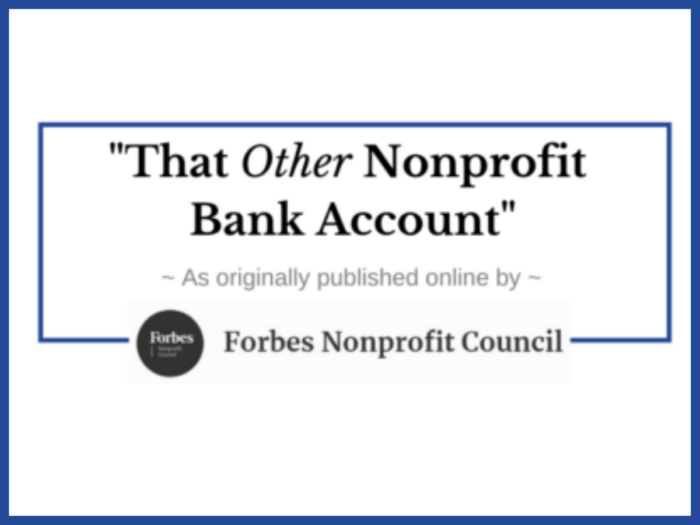Convergent Note: The following article was recently published online by Forbes Nonprofit Council and written by Senior Project Director Carlotta Ungaro.
That other nonprofit bank account
When an individual or business makes that investment in your nonprofit, the funds go into the bank account. But what about their deposit into the nonprofit’s other bank account?
In his book 7 Habits of Highly Effective People, Steven R. Covey coined the term “emotional bank account” to describe personal relationships. If only one person is making deposits into the emotional bank account, the relationship becomes “overdrawn,” and deteriorates.
In my experience, this concept is the same for building relationships with nonprofit donors or, as we call them, investors. When an individual or business invests in the organization’s monetary bank account, they also make a deposit in the organization’s relationship bank account. What’s more, this is the account from which they expect to make withdrawals. Successful nonprofits make sure that they, too, make deposits into the donor relationship bank account. How does a nonprofit do that?
One stellar nonprofit I recently worked with had intentionally built strong relationships with all of its investors/donors, with frequent contact, including one-on-one meetings and councils offering ongoing support and channels for input regarding how the nonprofit functioned. This nonprofit also did a great job of communicating its successes in fulfilling its mission. The retention rate for investors exceeded 90%. Many increased their investments, and the nonprofit exceeded its fundraising goal.
Make investor benefits a priority.
At the most basic level, the nonprofit should have a list of investor benefits, and they should be written down. Standard benefits include receiving regular communications, usually via an e-newsletter, and invitations to the nonprofit’s events and appropriate meetings. These are the “nickel and dimes deposits.” Higher-level “deposits” might include free tickets to an event or annual fundraiser, the individual or company’s name listed on the website or as an event sponsor, or perhaps a leadership role on a committee or task force for your nonprofit.
Make time for investors.
I have found that the most effective way for a nonprofit to make deposits in the emotional bank account is to foster genuine relationships with investors. The head of the nonprofit, whether it is a paid or unpaid position, should build into their schedule a regular block of time to spend time with investors. Interaction in person is preferred, but if distance or time makes this a challenge, routine phone calls or conversational emails can work in building rewarding relationships with investors. To effectively manage your interactions with investors, consider using customer relationship management (CRM) software to track communications efficiently, and set up reminders.
Reaching out to investors regularly is only the start of effective investor communication. There are two communication strategies that can create solid value for investors. The first is ensuring investors believe their opinions, as well as their dollars, will have a positive impact on the nonprofit’s strategies. Again, Steven R. Covey has addressed this with habit five: “Seek first to understand, then to be understood.” Approaching your conversations with investors with this mindset could yield a solid financial return on your investment and theirs.
The second strategy is to make it about them, even when discussing the nonprofit’s goals and accomplishments. The investor makes it possible for the organization to execute its strategies and reach its goals. By demonstrating to each investor repeatedly how their investment in your organization is having an impact, you will be able to show them that their deposit is generating a good return for their investment.
Just as in business, getting new investors in your nonprofit can often cost more than retaining existing investors. Finding time to make those deposits in your organization’s relationship banking account can take a back seat to mission execution. However, prioritizing it as a key strategy to accomplish the organization’s mission could make a difference in the organization’s success.






